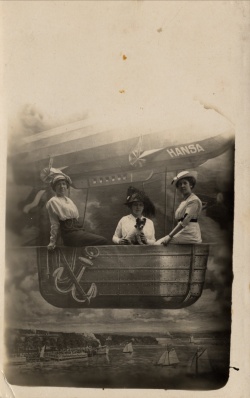There is Something in the Air
01. Sep. 2005

The Copenhageners were dumbfounded when the Hansa visited the city in 1912. Photo: The Royal Library.
Before as well as during and after its visit the air-ship is the centre of media and public interest. The very same day the newspaper "København" (Co-penhagen) wrote:
"On this day, which became a memorial day in the history of our city, one would jump out of bed and rush to the telephone. There was one confused questioning by telephone, from window to window, and on every street: Is the airship arriving? Soon it went from mouth to mouth: The "Hansa" has de-parted from Hamburg.
All living things got on their feet. A regular proces-sion of cyclists and automobiles moved out along Roskildevej and the old Køge Landevej; they wanted to meet the Zeppelin".

There was no end to the fascination of the zeppe-lins. Postcard with study photo of women in the gondola of the Hansa. Unknown photographer.
Whale of the Air
Hansa's visit in Copenhagen was literally a great event. Imagine the Round Tower put together four times, then add 2.5 m to the diameter of the tower, and you will come up with something that looks like the size of the airship which hovered above the city rooftops in 1912. Hansa was 148 m long and had a diameter of 14 m. It must have been an impressive sight. The Zeppelin was fascinating not only by its size, but also because it was an engineering achievement without comparison. Never before had it been possible to travel through the air in this way. The passengers would sit comfortably and sip their coffee at one of the tables in the salon while the landscape passed by deep down underneath.
Count Zeppelin launched his first airship in the year 1900, and 12 years later the expertise and routine were ready for international passenger flights. How-ever, it was by no means possible for just anybody to travel in this luxurious way. It was extremely ex-pensive to produce the giants and to keep them in the air. The Zeppelins required a large, specially trained crew and, in addition to this, an enormous ground crew with warping ropes to keep the airship at the ground. Letters and postcards were stamped onboard with special stamps often showing both route and airship. From the very beginning mail stamped onboard the "flying cigars" became col-lector's items. Sometimes mail was thrown out over chosen destinations in small bags with long ban-ners so that the point of impact could more easily be located.
This article may be copied or quoted with MuseumsPosten, Post & Tele Museum as source.
Comment this article
Only serious and factual comments will be published.